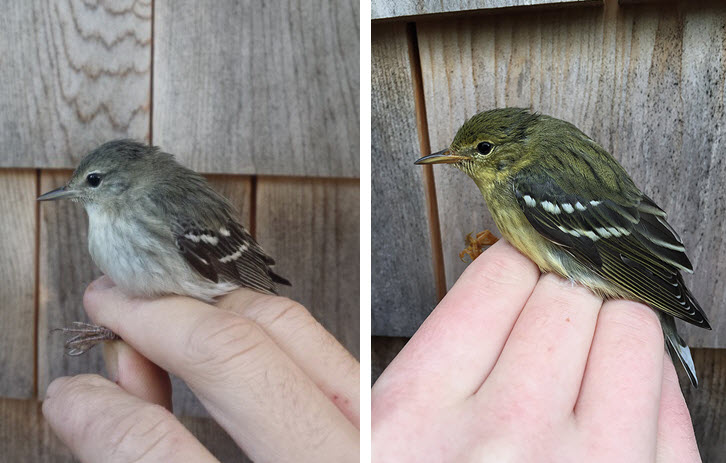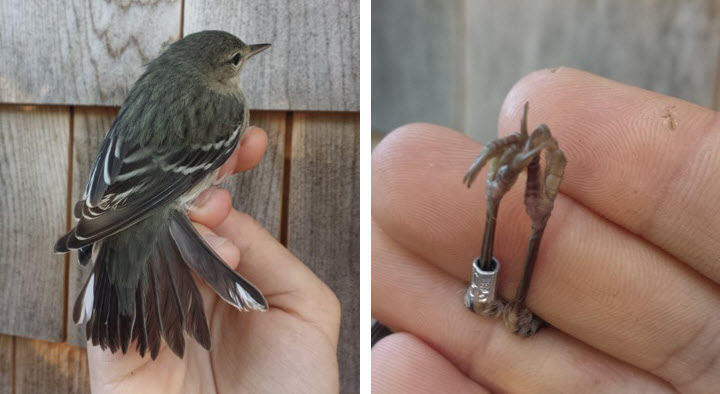Trevor Lloyd-Evans

Axanthic Blackpoll Warbler (left). Photograph by Alex Bartolo, Manomet Staff. Blackpoll Warbler in 1st basic plumage (right). Photograph by Emily Renaud, Manomet Staff.
On October 14, 2016, in the course of normal fall migration banding at the Bird Observatory in Manomet, Massachusetts, we mist netted a very washed-out looking Blackpoll Warbler (Setophaga striata). The bird’s black and white coloration was normal, its eye ring was white, and the rest of its plumage colors were grayish with just a faint touch of green. Measurements were normal: wing chord was 68 mm, mass was 12.5 g, and the skull was two-thirds ossified. So, it was a hatching year bird in first basic plumage that we would expect to have plenty of yellow and green coloration in the feathers, plus varying amounts of yellow in the feet. However, all yellow coloration seemed to be missing in the plumage. Even the toes and soles of the feet were dull grayish, so this bird did not fit the old banding mnemonic “blackpoll—yellow soles.”
What terminology should we use to describe this bird? A variety of related terms have been used to describe the condition in which plumage has excess yellow coloration including xanthochroism, xanthochromism, and xanthism (Leahy 2004, Davis 2007, Wikipedia 2017). A xanthic bird would thus be excessively yellow. In aviculture, xanthic birds are also called lutinos. Xanthochroism in wild birds has been recorded in a number of species including Cape May Warbler (Schnell and Caldwell 1966). By analogy, the bird we captured, which apparently lacked the carotenoids required for yellow pigments, would be an axanthic Blackpoll. Jeff N. Davis, who wrote the article referenced above, kindly examined our photographs and was not aware of a published case specifically addressing this phenomenon (Davis personal communication). He commented that genetic mutation, physiological factors, or both may have disrupted normal carotenoid metabolism or expression. Dr. Jocelyn Hudon, Curator of Ornithology at the Royal Alberta Museum, agreed that the cause could be diet or a genetic anomaly. He agreed with the descriptor axanthic and suggested that retention of the melanins—dark pigments—would also make the bird schizochroic.

Axanthic Blackpoll Warbler (left). Close-up of Blackpoll Warbler soles (right). Photographs by Alex Bartolo, Manomet Staff.
Not just a confusing fall warbler, but also a splendid confusion of terms to describe its coloration and the causal factors.
I would like to thank the banding staff and members of Manomet who staff or support our migration banding studies, and also Jocelyn Hudon, Jeff Davis, and David Sibley for their expert opinions on this unusual Blackpoll.
References
- Davis, J. N. 2007. Color abnormalities in birds: A proposed nomenclature for birders. Birding 39: 36–46.
- Leahy, C. W. 2004. The Birdwatcher’s Companion to North American Birdlife. Princeton: Princeton University Press.
- Schnell, G. D. and L. D. Caldwell. 1966. Xanthochroism in a Cape May Warbler. The Auk. 83: 667–8.
- Wikipedia. 2017. Xanthochromism. Accessed June 14, 2017.